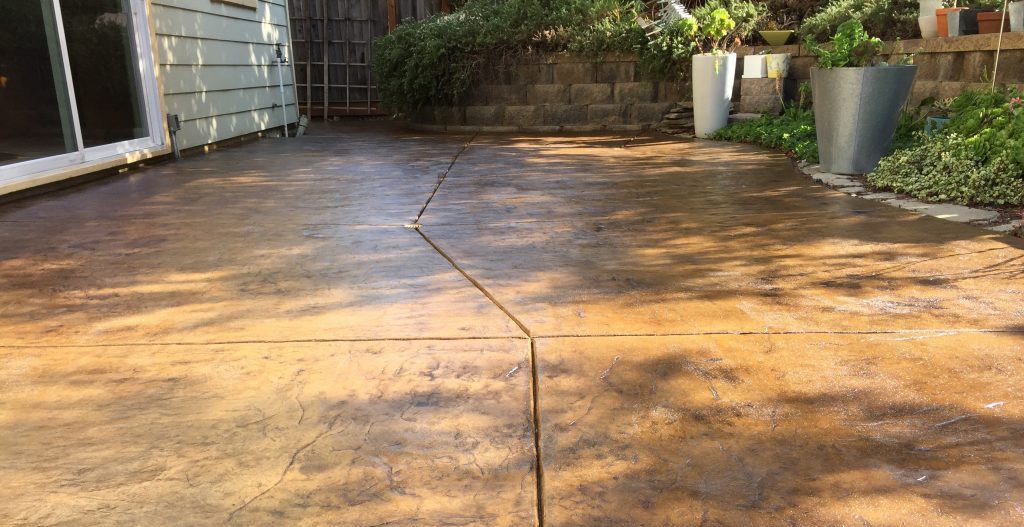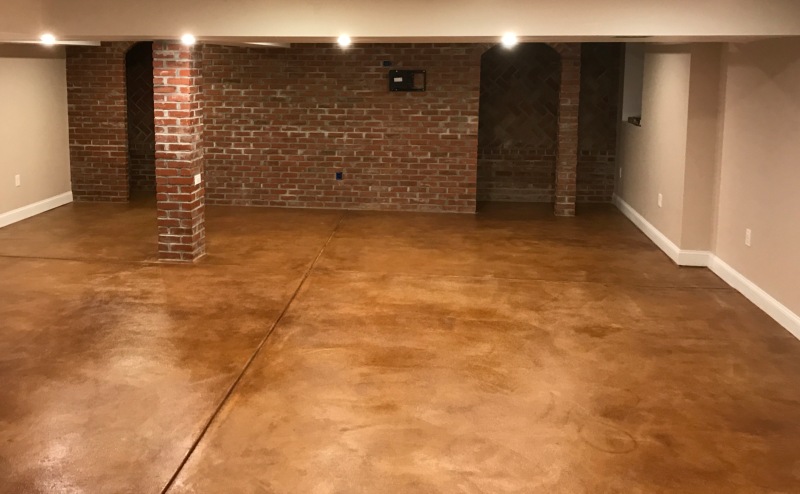All Concerning Stained Concrete: A Comprehensive Overview to Its Advantages and Applications
Stained concrete has become a prominent choice for both property and business spaces. Its capacity to incorporate visual appeal with usefulness makes it an appealing choice. Various discoloration strategies offer a range of shades and finishes, enabling customization. Nevertheless, the benefits expand beyond look. Understanding its applications and maintenance requirements is crucial for any person considering this functional material. The subtleties of stained concrete invite even more exploration.
What Is Stained Concrete?

Staining can be put on numerous surfaces, consisting of floors, driveways, and patios, making it a functional choice for both indoor and outdoor spaces. The treatment can accomplish a range of looks, from natural tones to bold, modern designs. Unlike paint, stained concrete preserves its look gradually, as it ends up being an essential part of the concrete itself. Generally, stained concrete functions as an efficient approach for transforming ordinary concrete into visually striking surfaces.
Benefits of Stained Concrete
Stained concrete offers substantial advantages, especially in aesthetic charm and toughness - local stained concrete. Its vivid shades and one-of-a-kind patterns enhance the aesthetic appeal of any area, making it a popular selection for both household and industrial applications. Additionally, the long life of stained concrete warranties that it remains a practical financial investment in time, standing up to deterioration
Visual Appeal
One of one of the most compelling advantages of utilizing stained concrete is its remarkable visual charm. Stained concrete offers an one-of-a-kind and flexible look that can match numerous design styles, from modern-day to rustic. The infusion of lively colors and elaborate patterns permits homeowners and designers to develop customized surfaces that can boost the total ambiance of an area. Unlike standard floor covering choices, stained concrete can mimic the appearance of natural stone or polished marble, offering a high end look without the associated expenses. In addition, the glossy finish options can reflect light, additional brightening interiors. This flexibility makes stained concrete a favored option for both residential and business applications, where aesthetic impact is vital.
Toughness and Long life
The excellent visual qualities of stained concrete are matched by its impressive toughness and long life - stained concrete contractors. Stained concrete surfaces are resistant to wear and tear, making them suitable for high-traffic locations both indoors and outdoors. Their durable nature implies they can hold up against rough weather, including severe temperatures, rain, and UV direct exposure, without significant destruction. On top of that, stained concrete needs very little maintenance compared to various other floor covering choices, as it does not need frequent securing or redecorating. This durability not only minimizes substitute costs but likewise adds to a sustainable structure strategy. On the whole, stained concrete gives a long-lasting service that combines visual allure with practical advantages, guaranteeing its worth gradually
Different Types of Staining Methods
Various staining strategies can considerably affect the aesthetic qualities of concrete surface areas. The 3 key methods include acid discoloration, which responds chemically with the concrete, water-based staining, which offers a more comprehensive series of shades, and overlay staining choices that give a fresh surface. Each technique has unique attributes and applications that accommodate different style preferences and project needs.
Acid Discoloration Technique
How can property owners transform plain concrete surface areas right into visually striking attributes? One efficient approach is acid discoloration, a popular method that boosts the all-natural charm of concrete. This process involves applying a service of water, hydrochloric acid, and metal salts to the concrete surface area. As the acid reacts with the lime present in the concrete, it develops abundant, variegated colors that appear like marble or rock. Acid staining is recognized for its resilience and resistance to fading, making it a lasting option for both interior and outdoor applications. Nevertheless, it is necessary to keep in mind that the outcomes can differ based on the original concrete color and texture - stained concrete. Appropriate application and securing are essential for accomplishing the preferred aesthetic and long life
Water-Based Discoloration Strategy
A popular alternative to acid staining, the water-based staining strategy offers house owners a flexible method to improve concrete surface areas. This method makes use of water-soluble dyes and pigments, permitting for a variety of shades and coatings. Unlike acid stains, water-based stains can be put on unsealed concrete and provide an easier cleaning procedure. The outcomes can attain a more uniform appearance and can be layered to create one-of-a-kind effects. Additionally, water-based discolorations are typically less hazardous and discharge fewer volatile organic compounds (VOCs), making them a lot more environmentally pleasant. Home owners may value the capacity to personalize their concrete surfaces with numerous tones, enabling innovative expression while keeping sturdiness and longevity in their floor covering options.
Overlay Discoloration Options
Numerous overlay staining choices exist for property owners seeking to invigorate their concrete surface areas. One popular choice is acid staining, which responds chemically with the concrete to generate abundant, variegated colors. One more choice is water-based staining, using a more comprehensive shade scheme and less complicated application. Furthermore, concrete overlays can be integrated with patterns for complex styles, boosting appearances. For a much more textured coating, house owners might take into consideration utilizing stamped overlays that resemble my company all-natural products like stone or floor tile. Each technique offers unique advantages, from resilience to customization, enabling a personalized touch. Inevitably, the selection of overlay staining depends upon the preferred look and the condition of the existing concrete, making sure a freshened and attractive surface.
Applications of Stained Concrete
Stained concrete deals a versatile service for various applications, enhancing both visual allure and capability. This product is frequently utilized in domestic, industrial, and commercial setups, making it a prominent option among engineers and designers. In homes, stained concrete can work as stylish floor covering or exterior patios, providing a sophisticated appearance while continuing to be durable.
In commercial rooms, such as retail stores and dining establishments, stained concrete contributes to a modern-day setting and can hold up against hefty foot website traffic. Additionally, stained concrete is increasingly utilized in public spaces like parks and walkways, where its ability to mimic all-natural stone or various other products adds aesthetic rate of interest.
Stained concrete is excellent for swimming pool decks and driveways, supplying a slip-resistant surface that is easy to maintain. Generally, the adaptability of stained concrete makes it suitable for countless atmospheres, accommodating diverse preferences and requirements.
Upkeep and Look After Stained Concrete
Proper maintenance ensures the durability and elegance of stained concrete surface areas. Routine cleansing is crucial; utilizing a moderate cleaning agent and water with a soft-bristle brush helps eliminate dust and gunk without harming the coating. It is recommended to stay clear of severe chemicals that can strip away the tarnish or sealer.
Sealing read the article stained concrete is essential for defense against moisture, stains, and use. A high-quality sealant needs to be reapplied each to three years, depending on the website traffic and exposure the surface area withstands. Additionally, attending to spills without delay will avoid staining and discoloration.

Expense Considerations for Stained Concrete Projects
When planning a discolored concrete task, budget considerations play a necessary duty in identifying the total cost. The expenditures related to stained concrete can vary significantly based on numerous variables. Initially, the dimension of the area to be stained straight affects product and labor expenses. Larger rooms will naturally need even more resources. Second, the kind of discolor picked-- acid-based or water-based-- can affect pricing, with acid spots often being a lot more expensive. Furthermore, the intricacy of the layout, including patterns or numerous shades, can increase labor costs. Preparation work, such as cleaning and grinding the concrete surface, adds to the preliminary expenditures as well. Finally, the option between DIY setup and employing an expert service provider will better have a peek at this site impact the budget. Comprehending these elements enables house owners to make enlightened financial choices about their stained concrete jobs, guaranteeing they accomplish the wanted visual within their monetary ways.
Tips for Choosing the Right Stained Concrete for Your Area
Picking the best stained concrete for a particular space includes mindful consideration of different aspects past just budget plan. Initially, one need to review the desired use the location. High-traffic zones might need even more long lasting finishes, while ornamental applications can prioritize appearances.
The shade palette is another crucial facet; the chosen tones ought to balance with existing decor and lighting. It's likewise essential to think about the surface area appearance, as smooth surfaces can boost refinement, while distinctive alternatives might ensure safety in wet locations.
Local climate and ecological problems play a substantial duty in the long life and upkeep of stained concrete, affecting the choice of sealants and coatings.
Lastly, consulting with experts can give useful insights tailored to certain needs, assuring the option of the ideal stained concrete that straightens with both performance and style.

Regularly Asked Questions
Can Stained Concrete Be Applied Over Existing Flooring?
Stained concrete can certainly be used over existing flooring, supplied the surface is stable and sufficiently prepared. This method permits an aesthetic upgrade without the need for full removal of the original flooring materials.
How Much Time Does Stained Concrete Last?
Stained concrete can last for decades when effectively kept. Aspects such as website traffic, ecological conditions, and application techniques substantially influence its long life, with several setups continuing to be vibrant and intact for 10 to thirty years.
Is Stained Concrete Slippery When Damp?
Stained concrete can be slippery when wet, as the surface may develop a smooth surface. Using non-slip additives or textured coatings can reduce this problem, boosting safety and security without compromising the aesthetic allure of the concrete.
Can I Tarnish Concrete Myself, or Should I Work with a Specialist?
The decision to stain concrete directly or work with an expert hinges on skill degree and task intricacy. While DIY staining can save money, experts ensure ideal results, particularly for intricate layouts or large surface areas.
What Colors Are Readily Available for Stained Concrete?
The selection of colors offered for stained concrete includes natural tones like browns and tans, vibrant shades such as reds and blues, and softer colors like pastels. This combination enables for imaginative, tailored design alternatives.